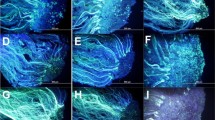Abstract
In garden asparagus, Fusarium crown and root rot is the main cause of crop decline. Since chemical treatments are inefficient, efforts should focus on the development of resistant cultivars to control the disease. Toxic culture filtrate (TCF) of F. oxysporum has affected asparagus pollen germination and tube growth. Consequently, gametophyte selection was evaluated to ascertain if the application of selective agents at this level could increase selection efficiency. Two susceptible pistillate plants and one tolerant and one susceptible staminate plants were used in controlled crosses. Before pollination, a drop of a germination vehicle with TCF or without it was applied to the stigmas. Some pollinated pistils were fixed and analyzed by fluorescence microscopy; the rest were left on the plant for seed production. Fifty to 200 seeds were obtained per treatment combination (staminate plant x pistillate plant x pollination vehicle). The derived plantlets were inoculated in vitroand evaluated for disease symptoms. The application of TCF to stigmas reduced pollen germination and tube growth compared with untreated controls,regardless of the genotypic combination. Pollen germination and tube growth was poorer for the tolerant staminate genotype than for the susceptible one. When the TCF was applied, the number of seeds per pollination in comparison with the controls diminished only when the susceptible genotype was the pollinator. The percentage of affected root area of the progenies obtained after applying the TCF was lower than in the controls only when the tolerant genotype was the pollinator. Increasing Fusarium resistance in asparagus by means of gametophyte selection seems feasible.
Similar content being viewed by others
References
Bruna, A., 1991. Marchitez y pudriciones de corona y raíces en espárrago (Asparagus officinalis L.)causado por Fusarium oxysporum Schlecht f. sp. asparagi Cohen. Agricultura Técnica (Chile) 51(1): 52–54.
Cohen, S.Y. & F.D. Heald, 1941. A wilt and root rot of asparagus caused by Fusarium oxysporum (Schlecht).Plant Dis Rep 25: 503–509.
Compton, M.E., 1994. Statistical methods suitable for the analysis of plant tissueculture data. Pl Cell Tiss Org Cult 37: 217–242.
Darakov, O.B., 1995. Gametophyte selection of tomatoesfor resistance to early blight disease. Sex Plant Reprod 8: 95–98.
Ellison, J.H., 1986. Asparagus breeding.In: M.J. Bassett (Ed.), Breeding Vegetable Crops, pp. 521–569. Avi, Wesport, Connecticut.
Endo, R.M. & E.C. Burkholder, 1971. The association of Fusarium moniliforme with the crown rot complex of asparagus (Abst). Phytopathology 61: 891.
Hormaza, J.I. & M. Herrero, 1992. Pollen selection. Theor Appl Genet83: 663–672.
Hormaza, J.I. & M. Herrero, 1996. Male gametophytic selection as a plant breeding tool.Scientia Hortic 65: 321–333.
Lacy, M.L., 1979. Effects of chemicals on stand establishment and yields ofasparagus. Plant Dis Rep 63: 612–616.
Lassaga, S.L., E.L. Camadro & F.J. Babinec, 1998. Assesinggenetic variability for Fusarium resistance in three asparagus populations with an in vitro assay. Euphytica 103: 131–136.
Lewis, G.D. & P.B. Schoemaker, 1964. Resistance of Asparagus species to Fusarium oxysporum f. sp.asparagi. Plant Dis Rep 48: 364–365.
Martin, F.W., 1958. Staining and observing pollen tubes in the styleby means of fluorescence. Stain Tech 34: 125–128.
Murashige, T. & F. Skoog, 1962. A revisedmedium for rapid growth and bioassays with tobacco tissues cultures. Physiol Plant 15: 473–479.
Ottaviano, E. & D.L. Mulcahy, 1989. Genetics of angiosperm pollen. Adv Genet 26: 1–64.
Ottaviano, E., M.E. Pè & G. Binelli, 1991. Genetic manipulation of male gametophytic generation in higher plants. In: B.B. Biswas & J.R. Harris (Eds.), Plant Genetic Engineering, Vol 17, Subcellular Biochemistry, Plenum Press, New York, USA.
Pontaroli, A.C., E.L. Camadro, F.J. Babinec & A. del C. Ridao, 2000. Responses of Asparagus officinalis pollen tothe culture filtrate of Fusarium oxysporum f. sp. asparagi. Sci Hortic 84: 349–356.
Ridao, A. del C., 1992.La fusariosis como causa del declinamiento de las esparragueras. CERBAS, Unidad Integrada Balcarce (EEA INTA - F.C.A., UNMdP), E.E.A. Hilario Ascasubi, 14 pp.
Sari-Gorla, M., C. Frova, G. Binelli & E. Ottaviano, 1986.The extent of gametophytic-sporophytic gene expression in maize. Theor Appl Genet 72: 42–47.
SAS Institute,1998. SAS/STATTM for WindowsTM User's guide, Release 6.12 Edition. SAS Inst. Inc., Cary, North Carolina, 1028 pp.
Simon, C.J. & J.C. Sanford, 1986. Induction of gametic selection in situ by stylar applications of selectiveagents. In: D. Mulcahy, G. Bergamini & E. Ottaviano (Eds.), Biotechnology and Ecology of Pollen, pp. 107–112, Springer Verlag Berlin, Heidelberg, New York.
Stephens, C.T., R.M. De Vries & K.C. Sink, 1989. Evaluationof Asparagus species for resistance to Fusarium oxysporum f. sp. asparagi and F. moniliforme. Hort Science 24(2): 365–368.
Tanskley, S.D., D. Zamir & C.M. Rick, 1981. Evidence for extensive overlap of sporophytic andgametophytic gene expression in Lycopersicon esculentum. Science 213: 453–455.
Tarchini, R., M. Sari-Gorla & M.E. Pè, 1994. Male gametophytic selection: Perspectives for sorghum and pearl millet improvement. In: Use of Molecular Markers in Sorghum and Pearl Millet Breeding for Developing Countries, pp. 46–52, Proc ODA Plant Sci Res Prog Conf, Norwich, UK.
Ter-Avanesian, D.V., 1978. The effect of varying the number of pollen grains used infertilization. Theor Appl Genet 52: 77–79.
Trexler, J.C. & J. Travis, 1993. Nontraditional regressionanalysis. Ecology 74(6): 1629–1637.
Tu, C.C., Y.H. Cheng & A.S. Cheng, 1985. A rapid method fortesting resistance to Fusarium wilt in asparagus hybrids. In: E.C. Lougheed & H. Tiesser (Eds.), Proc 6th Int Asparagus Symp, University of Guelph, Ontario.
Williams, E.G., R.B. Knox & J.L. Rouse, 1982. Pollination subsystemsdistinguished by pollen tube arrest after incompatible interespecific crosses in Rhododendron (Ericaceae). J Cell Sci 53: 255–277.
Willing, R.P. & J.P. Mascarenhas, 1984. Analysis of the complexity and diversity of mRNAs frompollen and shoots of Tradescanthia. Plant Physiol 75: 865–868.
Author information
Authors and Affiliations
Rights and permissions
About this article
Cite this article
Pontaroli, A.C., Camadro, E.L. Increasing resistance to Fusarium crown and root rot in asparagus by gametophyte selection. Euphytica 122, 343–350 (2001). https://doi.org/10.1023/A:1012983123410
Issue Date:
DOI: https://doi.org/10.1023/A:1012983123410




